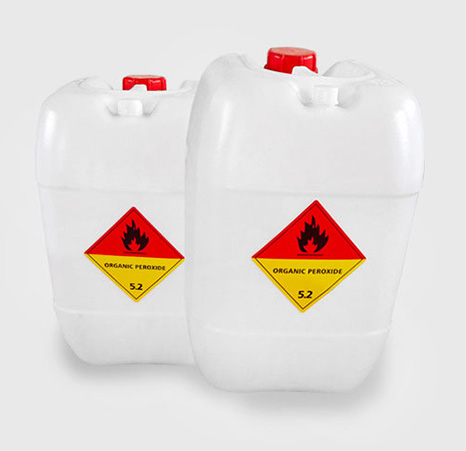Two benzoyl peroxide production wastewater treatment and resource recovery technology
abstract
The present invention discloses a treatment and resource utilization process for wastewater from the production of benzoyl peroxide (initiator BPO). The process involves stabilizing the high concentration production wastewater collected from the discharge outlet of the production device, basically eliminating the danger of severe decomposition of organic peroxides in the wastewater when exposed to heat, and separating and recovering benzoic acid and sodium chloride from the wastewater. Benzoic acid can be reused in production, with sodium chloride as a byproduct. After the removal of benzoic acid and sodium chloride, the low concentration wastewater is subjected to hydrolysis contact oxidation and C-Fe micro electrolysis decolorization treatment. The main drainage indicators meet the requirements of the "Water Pollutant Discharge Standard for Chemical Synthesis Pharmaceutical Industry" (GB21904-2008) for the discharge limit of water pollutants for new enterprises.
right-claiming document
1. The treatment and resource utilization process of benzoyl peroxide production wastewater is characterized in that it includes the following process steps:
(1) Treatment process for mother liquor of benzoyl peroxide synthesis:
Recovery of benzoic acid: Add hydrochloric acid to the mother liquor of benzoyl peroxide production for acidification to pH<5, and filter out the acidified
benzoic acid;
Separation of low concentration wastewater: Add 1-2 grams of sodium sulfite to each liter of wastewater, slowly heat to 70-80 ℃, stir for 1.5-2 hours, and separate low concentration acidic wastewater through vacuum distillation;
Recovery of sodium chloride: During the process of vacuum distillation, sodium chloride crystals containing benzoic acid are generated, filtered out, and the mother liquor is returned to vacuum distillation to continue separating low concentration wastewater. At the same time, sodium chloride crystals are filtered out;
The sodium chloride crystals filtered out by purifying sodium chloride are dissolved in the low concentration wastewater separated above. The sludge is first filtered out, then acidified with hydrochloric acid to pH<5, and then filtered again to recover benzoic acid; After separating benzoic acid, the filtrate is circulated and distilled, while continuing to separate low concentration wastewater while recovering sodium chloride;
Biochemical treatment of low concentration wastewater: The separated low concentration acidic wastewater is neutralized to neutral, subjected to hydrolysis contact oxidation, and then subjected to C-Fe micro electrolysis decolorization treatment before reaching the standard for discharge;
(2) Treatment of wastewater from benzoyl peroxide washing
Collect water washing wastewater of benzoyl peroxide products from the discharge outlet of the production unit; The treatment process includes: separation of low concentration wastewater, recovery of sodium chloride, purification of sodium chloride, and biochemical treatment of low concentration wastewater;
Separation of low concentration wastewater: Add 1-2 grams of sodium sulfite to each liter of benzoyl peroxide product washing wastewater, slowly heat to 70-80 ℃, stir for 1.5-2 hours, and then separate the low concentration wastewater through atmospheric distillation;
Recovery of sodium chloride: During the distillation process, sodium chloride crystals containing benzoic acid are generated, and the crystals are filtered out; Continue vacuum distillation of the filtrate to separate low concentration wastewater while recovering sodium chloride;
Purification of sodium chloride: Crystallization of sodium chloride containing benzoic acid is dissolved in low concentration wastewater obtained from the above separation. The sludge is first filtered, then acidified with hydrochloric acid to pH<5, and benzoic acid is filtered and recovered; Continue vacuum distillation of the filtrate after separating benzoic acid, and recover sodium chloride while separating low concentration wastewater;
Biochemical treatment of low concentration wastewater: The separated low concentration acidic wastewater is neutralized to neutral, subjected to hydrolysis contact oxidation, and then subjected to C-Fe micro electrolysis decolorization treatment before reaching the standard for discharge.
instructions
Treatment and resource utilization process of wastewater from benzoyl peroxide production
technical field
The present invention belongs to the field of industrial wastewater treatment technology, and relates to an organic peroxide production wastewater treatment and resource utilization process, in particular to a benzoyl peroxide (initiator BPO) production wastewater treatment and resource utilization process.
Background technology
Benzoyl peroxide (initiator BPO) is a highly active organic peroxide. Mainly used as a polymerization initiator for PVC and polyacrylonitrile, as well as a crosslinking agent for unsaturated polyester and acrylate. Used as a crosslinking agent for silicone rubber and fluororubber in the rubber industry. Bleaching agents for flour, oil, wax, and cosmetic additives.
The production characteristic is that the process is intermittent, and the water quality and quantity, organic matter concentration, acidity and alkalinity, salt content, BOD/CDO value of the wastewater vary greatly with the production scale and time. Organic peroxides are thermally unstable and prone to accelerated decomposition. Organic peroxides dissolved in wastewater also rapidly decompose at high temperatures. The wastewater from the production of benzoyl peroxide contains a large amount of sodium chloride, benzoic acid, and sodium benzoate. The concentration of pollutants is high, and it has a strong inhibitory effect on biodegradation. The B/C value is very low, and the biodegradability is poor. Direct discharge of this type of wastewater into rivers can cause serious water pollution.
The raw materials for the production of benzoyl peroxide include hydrogen peroxide, sodium hydroxide, benzoyl chloride, etc. The different production stages of benzoyl peroxide produce wastewater with different properties, mainly including synthetic mother liquor and washing wastewater. The synthetic mother liquor contains sodium hydroxide, hydrogen peroxide, sodium peroxide, benzoyl peroxide, sodium benzoate, sodium chloride, etc., with a CODcr of 93600.40 mg/L to 33848.32mg/L; pH>7; Contains 11.6-15.1% (Wt) of non volatile solids (salts, alkalis, etc.). The washing wastewater contains sodium hydroxide, benzoyl peroxide, sodium benzoate, sodium chloride, etc. CODcr=39816.20~16731.84mg/L, pH: 7-8; The content of non volatile solids (salt, alkali, etc.) is 2.56-1.98% (Wt). Due to the high concentration, high salinity or alkalinity, and thermal instability of wastewater from the production of benzoyl peroxide, it is an environmental challenge in wastewater treatment.
According to literature reports, currently, organic peroxide wastewater with high salt content, high acid content, high alkali content, and difficult to degrade is generally treated using methods such as electrolysis, dilution incineration and dilution biochemistry, desalination dilution biochemistry, etc. A typical treatment process is to collect organic peroxide production waste liquid, product washing waste liquid, tail gas treatment waste alkali liquid, cooling tower sewage, equipment and ground flushing water, etc., and mix them in an acidification tank. Then, hydrochloric acid is added to adjust the pH to 2-4, causing the organic matter to precipitate, and then gravity sedimentation is carried out. The upper organic phase obtained by sedimentation is collected and diluted with diesel to reduce the concentration of organic peroxides before being transported for incineration. The lower acidic water obtained from sedimentation is neutralized to neutral with NaOH, and then sent to the regional sewage treatment plant for dilution with 200 times low salinity water, so that the salt content of the wastewater is less than 1%. Then, a three tank oxidation ditch is used for biochemical treatment. Biochemistry is inhibited when the concentrations of tert butanol and sodium benzoate are high. The disadvantage of this treatment process is that the concentration of organic peroxide wastewater is high, and the organic matter obtained from acidification separation needs to be diluted with diesel before incineration, resulting in no recovery of resources and serious waste. After separation, the concentration of organic matter in the wastewater is still relatively high, and there are many components that inhibit microorganisms, which increases the treatment load of the regional sewage treatment plant. The regional sewage treatment plant should set up a dedicated regulating tank to dilute the wastewater and then perform biochemical treatment. Additionally, this treatment process is only suitable for treating highly concentrated alkaline wastewater. In alkaline wastewater, organic acid salts with high solubility are converted into organic acids with relatively low solubility after acidification and are separated. Acidification has almost no separation effect on low molecular weight organic acids and alcohols.
summary of the invention
The present invention aims to address the shortcomings of existing treatment technologies and provide a wastewater treatment and resource utilization process for the production of tert butyl benzoate peroxide.
The present invention relates to the treatment and resource utilization process of benzoyl peroxide production wastewater, which involves collecting high concentration production wastewater from the discharge outlet of the production device, adding hydrochloric acid acidification to the wastewater to convert sodium benzoate into benzoic acid and precipitate it. Filter and recover benzoic acid, then add reducing agents to reduce organic peroxides, and control the temperature below the accelerated decomposition temperature of organic peroxides to slowly decompose, eliminating the danger of severe peroxide decomposition in wastewater and achieving stability. The stabilized wastewater is separated into low concentration wastewater through distillation. During the distillation and concentration process, crystals with sodium chloride as the main component are generated. The crystals are filtered out in a timely manner, and the filtrate is returned to the distillation system. The recovered crystals are dissolved in the separated low concentration wastewater, filtered to remove the sludge, and then acidified with hydrochloric acid to separate benzoic acid. The filtrate is concentrated to recover sodium chloride. The separated low concentration wastewater is subjected to neutralization, hydrolysis acidification contact oxidation treatment, and then subjected to C-Fe micro electrolysis decolorization. The main indicators of drainage meet the requirements of the "Water Pollutant Discharge Standards for Chemical Synthesis Pharmaceutical Industry" (GB21904-2008) for the discharge limits of water pollutants for newly built enterprises.
The specific process is as follows:
(1) Treatment process for mother liquor of benzoyl peroxide (initiator BPO) synthesis:
Recovery of benzoic acid: Add hydrochloric acid to the mother liquor of benzoyl peroxide production for acidification to pH<5, and filter out the acidified benzoic acid;
Separation of low concentration wastewater: Add 1-2 grams of sodium sulfite to each liter of wastewater, slowly heat to 70-80 ℃, stir for 1.5-2 hours, and separate low concentration acidic wastewater through vacuum distillation;
Recovery of sodium chloride: During the process of vacuum distillation, sodium chloride crystals containing benzoic acid are generated, filtered out, and the mother liquor is returned to vacuum distillation to continue separating low concentration wastewater. At the same time, sodium chloride crystals are filtered out;
The sodium chloride crystals filtered out by purifying sodium chloride are dissolved in the low concentration wastewater separated above. The sludge is first filtered out, then acidified with hydrochloric acid to pH<5, and then filtered again to recover benzoic acid; After separating benzoic acid, the filtrate is circulated and distilled, while continuing to separate low concentration wastewater while recovering sodium chloride;
Biochemical treatment of low concentration wastewater: The separated low concentration acidic wastewater is neutralized to neutral, subjected to hydrolysis contact oxidation, and then subjected to C-Fe micro electrolysis decolorization treatment before reaching the standard for discharge;
(2) Treatment of wastewater from benzoyl peroxide washing
Collect water washing wastewater of benzoyl peroxide products from the discharge outlet of the production unit; The treatment process includes: separation of low concentration wastewater, recovery of sodium chloride, purification of sodium chloride, and biochemical treatment of low concentration wastewater;
Separation of low concentration wastewater: Add 1-2 grams of sodium sulfite to each liter of benzoyl peroxide product washing wastewater, slowly heat to 70-80 ℃, stir for 1.5-2 hours, and then separate the low concentration wastewater through atmospheric distillation;
Recovery of sodium chloride: During the distillation process, sodium chloride crystals containing benzoic acid are generated, and the crystals are filtered out; Continue vacuum distillation of the filtrate to separate low concentration wastewater while recovering sodium chloride;
Purification of sodium chloride: Crystallization of sodium chloride containing benzoic acid is dissolved in low concentration wastewater obtained from the above separation. The sludge is first filtered, then acidified with hydrochloric acid to pH<5, and benzoic acid is filtered and recovered; Continue vacuum distillation of the filtrate after separating benzoic acid, and recover sodium chloride while separating low concentration wastewater;
Biochemical treatment of low concentration wastewater: The separated low concentration acidic wastewater is neutralized to neutral, subjected to hydrolysis contact oxidation, and then subjected to C-Fe micro electrolysis decolorization treatment before reaching the standard for discharge.
Compared with prior art, the present invention has the following advantages:
1. The present invention directly takes production wastewater from the discharge outlet of the production device, first separates and recovers benzoic acid and sodium chloride in the wastewater, separates low concentration wastewater during the process of recovering chemical raw materials, and then conducts biochemical treatment on the separated low concentration wastewater to meet the requirements of the "Water Pollutant Discharge Standard for Chemical Synthesis Pharmaceutical Industry" (GB21904-2008) for the discharge limit of water pollutants for new enterprises.
2. The production raw materials recovered from wastewater have high purity and good quality. The resource utilization of pollutants in wastewater has been achieved, which meets the development requirements of circular economy and energy conservation and emission reduction. At the same time, conditions have been created for the biochemical treatment of wastewater.
3. The present invention is closely combined with production practice, with reasonable design, advanced technical route, relatively simple operation, and no secondary pollution generated during the treatment process.
4. Compared with current electrolysis, dilution incineration, and dilution biochemical technologies at home and abroad, it achieves biochemical treatment of refractory wastewater while recovering a large amount of chemical production raw materials, saving treatment costs, and effectively protecting resources and the environment.
Specific implementation method
The following provides a detailed explanation of the treatment and resource utilization process of the wastewater from the production of benzoyl peroxide (initiator BPO) in the present invention through specific examples.
1. Treatment process for mother liquor of benzoyl peroxide (initiator BPO) synthesis:
Collect 20 liters of benzoyl peroxide production mother liquor from the discharge outlet of the production unit. Wastewater CODcr=33848.32mg/L; pH=12.5; Contains 15.1% non volatile solids.
The treatment process includes: recovery of benzoic acid, separation of low concentration wastewater, recovery of sodium chloride, purification of sodium chloride, and biochemical treatment of low concentration wastewater.
Recovery of benzoic acid: First add hydrochloric acid to the wastewater for acidification to pH<5, and filter out the acidified benzoic acid.
Separation of low concentration wastewater: After separating benzoic acid, add 20 grams of sodium sulfite (1 gram per liter of wastewater), slowly heat to 70-80 ℃, stir for 1.5 hours, and separate low concentration acidic wastewater through vacuum distillation.
Recovery of sodium chloride: During the process of vacuum distillation, sodium chloride crystals containing benzoic acid are generated, filtered out, and the filtered mother liquor is returned to vacuum distillation for further concentration.
Sodium chloride purification: Sodium chloride crystals containing benzoic acid are dissolved in the low concentration wastewater separated above. The sludge is first filtered out, then acidified with hydrochloric acid to pH<5, and then filtered again to recover benzoic acid. The filtrate after separating benzoic acid is subjected to cyclic distillation, and sodium chloride is filtered and recovered while continuing to separate low concentration wastewater.
Low concentration wastewater biochemical treatment: The separated low concentration acidic wastewater has a CODcr of 4583.07mg/L, and a CODcr removal rate of 86.46%. After neutralization to neutral, it undergoes hydrolysis contact oxidation, and then undergoes C-Fe micro electrolysis decolorization treatment before reaching the discharge standard.
A total of 0.3kg of benzoic acid was recovered and 1.6kg of refined sodium chloride was obtained. After the dissolution of sodium chloride crystals and filtration, a small amount of sludge can be incinerated for treatment.
2. Treatment of wastewater from benzoyl peroxide washing
Collect 20 liters of benzoyl peroxide product washing wastewater from the discharge outlet of the production unit. CODcr=16731.84mg/L; pH:7~8; Contains 1.98% non volatile solids.
The treatment process includes: separation of low concentration wastewater, recovery of sodium chloride, purification of sodium chloride, and biochemical treatment of low concentration wastewater.
Separation of low concentration wastewater: Add 20 grams of sodium sulfite (1.0 grams of sodium sulfite per liter of wastewater) to the wastewater and slowly heat it to 70-80 ℃. After stirring for 1.5 hours, separate the low concentration wastewater through atmospheric distillation.
Recovery of sodium chloride: Sodium chloride crystals containing benzoic acid are generated during the distillation process. Filter out crystals. Vacuum distillation of filtrate continues to separate low concentration wastewater while recovering sodium chloride.
Sodium chloride purification: Sodium chloride containing benzoic acid is crystallized and dissolved in low concentration wastewater obtained through separation. The sludge is first filtered, and then acidified with hydrochloric acid to pH<5 to obtain benzoic acid through filtration. The filtrate after separating benzoic acid is returned to reduced pressure concentration.
Biochemical treatment of low concentration wastewater: The separated low concentration acidic wastewater has a CODcr of 76.46mg/L, and a CODcr removal rate of 99.54%. After neutralization to neutral, it undergoes hydrolysis contact oxidation, and then undergoes C-Fe micro electrolysis decolorization treatment before reaching the discharge standard.
A total of 0.17 kg of benzoic acid was recovered and 0.75 kg of refined sodium chloride was purified. The sludge filtered out after the dissolution of sodium chloride crystals containing benzoic acid can be landfill or incinerated for treatment.
Quality inspection results of recycled production raw materials:
① Quality test results of recovered sodium chloride
Analysis project analysis result% (Wt) NaCl 98.44 Ca2+0.01 Mg2+0.01 SO42+0



